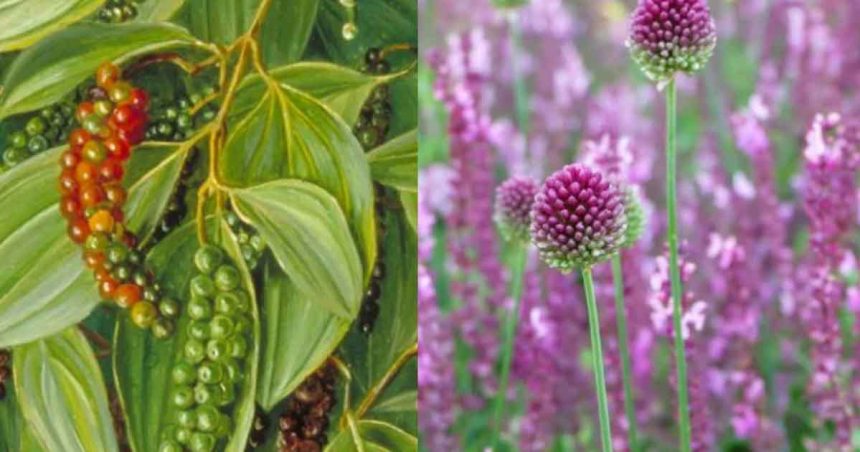Nowadays, the journey from field to table for the food we eat can be quite long. Never before in history have we had such access to food from around the world. With incredible preservation methods and fast transportation, we can enjoy pineapples in Minnesota during January, even if they come from a can. However, being so far removed from our food sources, most of us have no idea what our food looks like while it’s growing. You might be surprised to learn that pineapples grow on individual stalks or that mustard starts as a beautiful yellow flower. Even your morning cup of coffee begins as a cluster of bright red berries.
Let’s face it — most of us don’t stop to think about where our food comes from. We just assume it grows the way we’ve always imagined. You probably think bananas grow on trees, right? They actually grow on enormous herbs covered in purple flowers. Chestnuts emerge from spine-covered pods, and peanuts are the roots of flowers. There’s a whole world of fascinating food out there. Here are 65 types of food that don’t grow the way you think.
Pineapples
Pineapples grow from spiky, ground-level bushes. The fruit develops in the center of the plant, and each bush produces just one pineapple at a time, taking about 18-24 months to mature.
Sesame Seeds
Sesame seeds come from tall, sprouting plants that grow straight up from the ground. The seeds are housed in small pods known as “buds,” and each pod can contain dozens of tiny seeds.
Artichokes
Artichokes are actually the large, edible flower buds of a plant that blooms into big, pretty purple flowers with feathery tops if left unharvested. They are usually picked before the flower opens.
Brussel Sprouts
Brussel sprouts, part of the Gemmifera group of cabbages, grow on a tall, leafy green stalk. Each sprout is about 2.5 to 4 cm in diameter, forming in clusters along the stalk, resembling miniature cabbages.
Capers
Capers are the unopened flower buds of a vine with pretty white flowers. These buds are usually pickled, providing a tangy, lemony flavor to various dishes.
Pistachios
Pistachios grow in clusters on trees and take seven to ten years to produce a significant yield, with peak production around 20 years. The nuts are harvested, dried, and often roasted. Interestingly, the pistachios resemble small mangoes when they’re on the tree.
Peanuts
Peanuts begin as pretty little yellow wildflowers above ground. When you pull up the plant, you’ll find the nuts in pods attached to the roots, revealing their status as underground legumes.
Vanilla Bean
Vanilla beans come from a flowering plant with delicate white flowers. The flowers produce long pods, which are then treated and dried to develop the rich vanilla flavor we use in cooking and baking.
Kiwis
Kiwis start out as flowers hanging on vines that grow along trellises. Over time, the flowers transform into the fuzzy, brown-skinned fruits that hang down until they are ready to be harvested.
Cashews
Cashews are particularly unusual. They grow on trees that produce cashew apples, and the nut itself forms at the bottom of the apple. The nuts are harvested, and their toxic shells are carefully removed before they are safe to eat.
Almonds
Almonds grow on flowering trees. The blossoms eventually turn into pods, and inside these pods, you’ll find the almonds. The trees bloom with beautiful white and pink flowers in the spring before developing the nut-bearing pods.
Saffron
Saffron is derived from the stigmas of bright purple crocus flowers. Each flower produces just three red stigmas, which are painstakingly harvested by hand and dried to become the saffron threads used in cooking.
Cinnamon
Cinnamon is actually the dried inner bark of certain tree species, primarily Cinnamomum verum. Harvesters peel off the bark and allow it to curl into quills as it dries, giving us the familiar cinnamon sticks.
Cranberries
Cranberries grow on low-lying, evergreen dwarf shrubs. The plants produce small pink flowers that develop into the tart red berries we enjoy in sauces and juices.
Cacao
Cacao, the source of chocolate, grows on trees that produce large pods. Inside these pods are cacao beans, which are harvested, fermented, dried, and processed to create chocolate products.
Coffee
Coffee begins as bright red or yellow cherries on coffee plants. Inside each cherry are the coffee beans. These cherries are harvested, and the beans are extracted, dried, roasted, and ground to make the coffee we drink.
Bananas
Bananas grow on large herbaceous plants that can reach up to 30 feet tall. These plants produce purple flowers, from which huge bunches of bananas emerge. Contrary to common belief, bananas grow stem-side down.
Quinoa
Quinoa grows on tall stalks that resemble flowering plants. The seeds are harvested and then rinsed to remove saponins, which have a naturally bitter taste. Quinoa is a highly nutritious grain alternative, gaining popularity for its health benefits.
Pomegranates
Pomegranates grow on small, spindly trees. Before harvest, the branches become heavy with the weight of the fruit. Pomegranate trees thrive in dry soil conditions, and overwatering can lead to disease.
Nutmeg
Nutmeg is typically sold ground, but in its original form, it looks more like a fruit. The nutmeg seed is found inside a yellow, apricot-like fruit, and it is dried and ground to produce the spice commonly used in cooking and baking.
Asparagus
Unlike many vegetables that grow on bushes or trees, asparagus sprouts straight up from the ground in individual stalks. It can take between two and three years for an asparagus plant to mature, but once it does, you can expect to harvest fresh stalks daily during the growing season.
Mango
Mangoes grow on trees in large clusters. Early in their growth cycle, mangoes are dark green and might be hard to recognize. As they ripen, they turn the familiar yellow, red, or orange color, indicating they’re ready to pick.
Starfruit
Starfruit, also known as carambola, is not widely known across the United States, but it can be found in some grocery stores. This fruit grows in clusters on small bushes and can even be grown in pots, making it accessible for home gardeners.
Dates
Dates grow on tall palm trees that can reach up to 75 feet in height. These trees thrive in warm climates, which helps the fruit develop its sweet, rich flavor. The height of the trees and the warm climate make harvesting dates a challenging task.
Camellia Tea
While tea is commonly known to be made from leaves, herbal teas like camellia tea are blends of various herbs and spices. Camellia tea specifically comes from the leaves of the Camellia sinensis plant, a flowering shrub or small tree.
Dragonfruit
Dragonfruit, known for its vibrant pink skin and creamy texture, is a strikingly unique fruit. It grows on a type of cactus with long, trailing leaves. The fruit hangs low amidst these unusual leaves, making it a fascinating sight.
Zucchini
Zucchini is a popular vegetable that grows low to the ground as part of a large bush. The plant produces thick, waxy vegetables alongside bright yellow flowers, which are also edible and often used in cooking.
Kidney Beans
Kidney beans, commonly used in chili, grow in pods similar to peas. These beans develop in small clusters inside long, dry pods, which are harvested and then shelled to extract the beans.
Persimmon
Persimmons grow on trees, which might be surprising given their resemblance to tomatoes. The trees have thick branches that support the weight of the fruit. Unlike tomatoes that grow on vines, persimmons thrive on these sturdy trees
Cloves
Cloves are the small, fragrant spice buds of a flowering tree. These buds are harvested before they open, and then dried to be used in cooking and baking, particularly in warm, aromatic dishes and beverages.
Lentils
Lentils are a protein-packed favorite among both vegetarians and meat-eaters. In the wild, you might mistake them for tall grass dotted with tiny pods. Each of these pods contains a few small lentil seeds, which are harvested and dried for culinary use.
Chickpeas
Chickpeas,…






